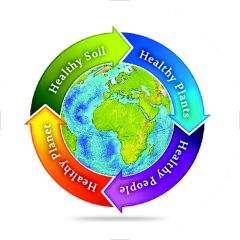No Sewage Sludge is Ever Used in NatureSoil Products
What Is Sludge?
Sludge, aka sewage sludge, is the residual semi-solid material that is a by-product of industrial and sewage wastewater treatment processes. In other words, it is the
biosolids that are left over from human waste that is removed from sewage water. Sewage sludge is known to contain not only large concentrations of toxic heavy
metal, but also dangerous disease bearing pathogens like E. coli, Salmonella, norovirus, and a host of other contaminants. Sludge is also known to contain
measurable levels of environmentally persistant chemicals such as polychlorinated biphenyls, dioxins, asbestos, PCBs, and hundreds of other toxins. Residual
pharmaceuticals and human hormones are among the other dangers of contaminants contained within sludge.
biosolids that are left over from human waste that is removed from sewage water. Sewage sludge is known to contain not only large concentrations of toxic heavy
metal, but also dangerous disease bearing pathogens like E. coli, Salmonella, norovirus, and a host of other contaminants. Sludge is also known to contain
measurable levels of environmentally persistant chemicals such as polychlorinated biphenyls, dioxins, asbestos, PCBs, and hundreds of other toxins. Residual
pharmaceuticals and human hormones are among the other dangers of contaminants contained within sludge.
Prior to 1992 this human sewage sludge was commonly disposed of by dumping it into oceans. After 1992 the U.S. banned this practice, leaving cities and
municipalities to begin disposing of it in landfills. Given the relative difficulty cities and municipalities have faced in disposing of this growing waste problem,
several companies embraced and began marketing it as a “nutrient rich” fertilizer. Biosolids were presented as a no to low cost alternative for farmers. This
process of spinning and rebranding sludge into beneficial fertilizer is well documented by authors John Stauber and Sheldon Rampton in their book, Toxic Sludge is
Good for You.
municipalities to begin disposing of it in landfills. Given the relative difficulty cities and municipalities have faced in disposing of this growing waste problem,
several companies embraced and began marketing it as a “nutrient rich” fertilizer. Biosolids were presented as a no to low cost alternative for farmers. This
process of spinning and rebranding sludge into beneficial fertilizer is well documented by authors John Stauber and Sheldon Rampton in their book, Toxic Sludge is
Good for You.
Research clearly shows that, under some conditions, toxic metals and organic industrial poisons can be transferred from sludge-treated soils into crops. Lettuce,
spinach, cabbage, Swiss chard, and carrots have all been shown to accumulate toxic metals and/or toxic chlorinated hydrocarbons when grown on soils treated with
sewage sludge. In some instances, toxic organics contaminate the leafy parts of plants by simply volatilizing out of the sludge. Small mammals have been shown to
accumulate heavy metals after sewage sludge was applied to forest lands.
spinach, cabbage, Swiss chard, and carrots have all been shown to accumulate toxic metals and/or toxic chlorinated hydrocarbons when grown on soils treated with
sewage sludge. In some instances, toxic organics contaminate the leafy parts of plants by simply volatilizing out of the sludge. Small mammals have been shown to
accumulate heavy metals after sewage sludge was applied to forest lands.
Sewage sludge is mutagenic (it causes inheritable genetic changes in organisms), but no one seems sure what this means for human or animal health. Researchers,
including hydrologists for the U.S. Geological Survey, tested an eastern Colorado wheat field that used treated sludge from a Denver sewage treatment plant.
Chemicals in antibacterial soaps, cleaners, cosmetics, fragrances and prescription drugs such as Prozac and Warfarin not only persisted in the topsoil, but migrated
downwards.
including hydrologists for the U.S. Geological Survey, tested an eastern Colorado wheat field that used treated sludge from a Denver sewage treatment plant.
Chemicals in antibacterial soaps, cleaners, cosmetics, fragrances and prescription drugs such as Prozac and Warfarin not only persisted in the topsoil, but migrated
downwards.
Though worms have been shown to effectively consume and digest this human sludge, and though worms have been proven to reduce the total levels of
contaminants after digestion, we feel there is no solid evidence that worm fed composted sludge material is any safer, or fit as a fertilizer. Beware! Many
inexpensive or value-priced brands of vermicast & vermicompost products are produced using sewage sludge.
contaminants after digestion, we feel there is no solid evidence that worm fed composted sludge material is any safer, or fit as a fertilizer. Beware! Many
inexpensive or value-priced brands of vermicast & vermicompost products are produced using sewage sludge.
The NatureSoil™ Advantage
NatureSoil Products™ are derived from 100% natural vegetative matter, and contain no sludge, or added chemical or synthetic components.
NatureSoil Products™ – Born of Nature. Back to Nature.
